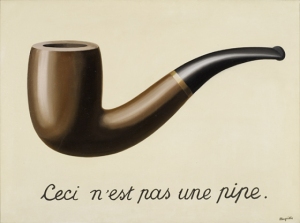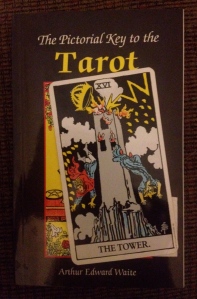I believe that words expand rather than limit our understanding of images. Some Tarot readers argue that definitions found in books can limit how cards are read. However, the words found in Tarot books are themselves just symbols and signs—they can be read like the pictorial symbols found in Tarot decks.
Consider the word apple. I can spend pages describing an apple—detailing its color, shape, size, texture, taste, and so on. But you can’t bake an apple pie with those words. When you read the word apple, your mind links the letters on the page (or screen) with your concept of an apple.
To put it another way, your brain turns otherwise random markings (the squiggles that make up the English language) into meaningful things. The word apple is a sign of the actual fruit.[1]
Both words and pictures are signs or representations. Consider the Magritte painting below:
 It says: “this is not a pipe.” I would add that the word pipe is also not a pipe. You can treat the word pipe just as you would treat a picture of a pipe.
It says: “this is not a pipe.” I would add that the word pipe is also not a pipe. You can treat the word pipe just as you would treat a picture of a pipe.
This becomes complicated when we read explanations of what the apple or pipe means. In a Tarot reading, we don’t say, “hey, look, there’s an apple” or describe the apple. We explain what the apple symbolizes—forbidden fruit, knowledge, making a pie. The more associations we have with apples, the stronger our readings of symbolism can become.
Many Tarot books define symbols found on the cards, which makes it difficult to remember that the words of these definitions are merely symbols themselves. We can divine meanings from the word-symbols; words are meant to be generative.
Take an example from the Rider-Waite-Smith deck and Waite’s book The Pictorial Key to the Tarot: The Tower (XVI). Waite writes:
There is a sense in which the catastrophe is a reflection from the previous card [The Devil]…one is concerned with the fall into the material and animal state, while the other signifies destruction on the intellectual side…The one is the literal word made void and the other its false interpretation.
Waite states what the card signifies—intellectual destruction.  His idea that words can be interpreted falsely leads the reader to think there is a singular correct meaning, and Waite’s words reveal that meaning.
His idea that words can be interpreted falsely leads the reader to think there is a singular correct meaning, and Waite’s words reveal that meaning.
However, the words themselves—“destruction on the intellectual side”—are symbols, and as such can generate several meanings. For instance, intentionally breaking down a problematic thought process (e.g. unlearning sexism) is very different than the involuntary biological loss of one’s mental capacity (e.g. Alzheimer’s disease). Both can be said to be intellectual destruction, and a Tarot reader could glean either meaning from the same card as well as the same words.
To decipher Waite’s text, we have to bring in our understanding of “destruction” and “intellect.” The word intellect, which is a sign like apple or pipe, is connected in our mind with a multifaceted concept. Is intellect problem-solving capacity, rhetorical prowess, and/or critical thinking skills? Is intellect the opposite of emotions or part of our emotional sphere? Dictionary and philosophical definitions of intellect are varied and change over time.
The more we read, the more avenues of inquiry open up. And intuition can help us select from the multiplicity of meanings found in Tarot texts. Reading words about Tarot cards will only expand our understanding of them—books help us build new mental bridges to delve deeper into symbolism.
[1] If you are interested a more in-depth discussion of the process of signification, check out the works of Claude Levi-Strauss and Ferdinand de Saussure.
